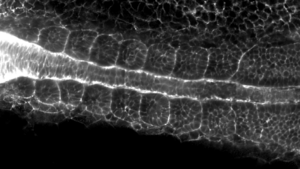Bilateral symmetry of the vertebrate musculoskeletal system is necessary for proper function and its defects are associated with debilitating conditions, such as scoliosis.
MPI-PKS and CSBD research group leader Marko Popović published a study in Nature with biologists from École polytechnique fédérale de Lausanne, Lausanne, Switzerland to address the role of surface tension in the symmertrical development of zebra fish embryos. The study entitled "Left–right symmetry of zebrafish embryos requires somite surface tension" focused on the early stage of body segmentation using zebrafish as a model organism. The researchers discovered that biochemical signalling and transcriptional processes that drive segmentation are not sufficient to explain the precision and symmetry of tissue shapes and sizes. In fact, they found that surface tension forces of the newly formed segments are a crucial component of the mechanism that is responsible for recovery and maintenance of the symmetric body plan. This discovery highlights the importance of physical interactions for precise and robust development of living beings.
S. R. Naganthan, M. Popovic, and A. C. Oates, Nature 605, 516-521 (2022)
